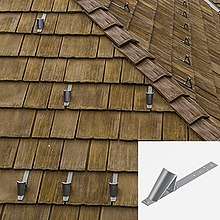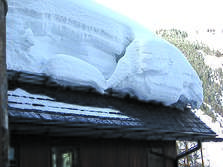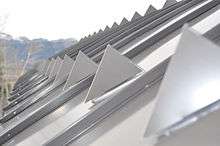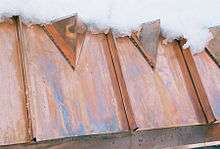Snow guard



Snow guards are rooftop devices that allow snow and ice to drop off in small amounts or allow snow and ice to melt completely before falling to the ground. The installation of snow guards prevents the sudden release of snow and ice from a roof, which is known as a roof avalanche. A roof avalanche can cause damage to people, pets, cars, landscaping, gutters, plumbing vents, lower roof areas, skylights and anything else that might be in the immediate area below your roof. Snow guards have been around for hundreds of years and have historically been used on slate, tile and metal roofs. The first snow guards were actually limbs that were attached to the eaves of a roof, with rocks placed atop the limbs, to hold the snow back.[1]
Variants of snow guards have been used for over 300 years all around the world where seasonal snowfall is common. In the Alps and Scandinavia, stones and logs were placed on top of roofs to increase friction and retention so that the snow could be used as insulation.[2] In addition to roofs, other larger natural or man-made objects and structures have also been used as snow guards (also known as snow fences) on steep sloping hills to lessen the effects of avalanches in valley regions.
In 1976 Jack McMullen invented the very first clear, polycarbonate snow guard. Then in 1979 a U.S. patent for the first clear plastic injection molded “corrosion proof snow guard” was granted.[3] \ Modern snow guards are made of polycarbonate and/or metals, depending on the type, size, and specific function of the guard. Although primarily installed for functional purposes, panel guards and snow railing are sometimes used to highlight a roof's aesthetic appeal and design. A variety of modern manufacturers have designed metal powder-coated guards that can match the colors of varying roof types, and snow rails are commonly colored to compliment the roofs they protect. In addition, many manufacturers have developed snow guards and systems for metal roofs.[4]
Snow guards are not the same as heat tape or trace heating systems used to melt snow faster, but these products can be and are commonly used together to offer better protection from sliding snow problems. Architects, contractors, and roofers are becoming increasingly aware of the importance and benefits of snow guards in the design process, minimizing the liability of falling snow for homeowners, businesses, and building owners.[5]

Other names
Other commonly used names and terms for snow guards include:
- Snow bracket
- Snow brake
- Snow stop
- Snow shields
- Snow clip
- Ice guard
- Snow fence (non-highway type)
- Snow rail
- Snow pads
- Snow dogs
- Snow guard bracket
References
- ↑ "ALPINE SNOWGUARDS". www.alpinesnowguards.com. Retrieved 2018-09-21.
- ↑ Hjorth-Hansen, Erik (2000). Snow Engineering : Recent Advances and Developments. Trondheim, Norway: Proceedings of the Fourth International Conference on Snow Engineering. p. 332.
- ↑ Snow Guard. "Plastic Snow Guards". SnoBlox/SnoJax Website. Retrieved 1 April 2014.
- ↑ Snow Guard. "Snow guards and metal roofs 101".
- ↑ Snow Guards. "Metal Roof Snow Guards". Metal Roof Snow Guards. Retrieved 8 February 2013.